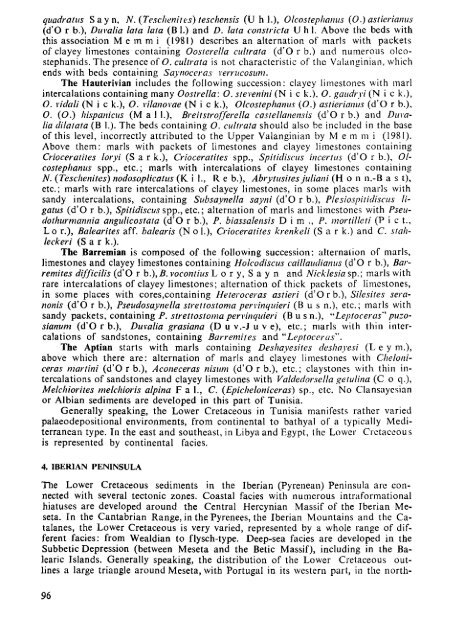THE MEDITERRANEAN LOWER CRETACEOUS
THE MEDITERRANEAN LOWER CRETACEOUS
THE MEDITERRANEAN LOWER CRETACEOUS
Create successful ePaper yourself
Turn your PDF publications into a flip-book with our unique Google optimized e-Paper software.
qiiadratus Sayn, N. (Tescheniic-s) teschensis (Ù h 1.), Olcostephanus (О.) astierianus<br />
(d'O г b.), Duvalia lata lata (В I.) and D. lata constricta U h 1. Above the beds with<br />
this association M e m m i (1981) describes an alternation of marls with packets<br />
of clayey limestones containing Oosterella cultrata (d'O r b.) and numerous olcostephanids.<br />
The presence of O. cultrata is not characteristic of the Valanginian, which<br />
ends with beds containing Saynoceras verrucosum.<br />
The Hauterivian includes the following succession: clayey limestones with marl<br />
intercalations containing many Oostrella: O. stevenini (N i с к.), О. gaudryi (N i с к.),<br />
О. vidait (N i с к.), О. vilanovae (N i с к.), Olcostephanus (О.) astierianus (d'O r b.),<br />
O. (O.) hispanicus (M a 1 !.), Breitstrofferella castellanensis (d'O r b.) and Duvalia<br />
dilatata (В 1.). The beds containing О. cultrata should also be included in the base<br />
of this level, incorrectly attributed to the Upper Valanginian by M e m m i (1981).<br />
Above them: marls with packets of limestones and clayey limestones containing<br />
Crioceratites loryi (S a r k.), Crioceratites spp., Spitidiscus incertus (d'O r b.), Olcostephanus<br />
spp., etc.; marls with intercalations of clayey limestones containing<br />
N. (Teschenites) nodosoplicatus (K. il., Re b.), Abrytusites juliani (Hon n.-B a s t),<br />
etc.; marls with rare intercalations of clayey limestones, in some places marls with<br />
sandy intercalations, containing Subsaynella sayni (d'O r b.), P/esiospitidiscus Hgatus<br />
(d'O r b.), Spitidiscus spp., etc.; alternation of marls and limestones with Pseudothurmannia<br />
angulicostata (d'O г b.), P. biassalensis Dim., P. mortilleti (P i с t.,<br />
Lo г.), Balearites aff. balearis (N о 1.), Crioceratites krenkeli (S a r k.) and C. staille<br />
ckeri (S a r k.).<br />
The Barremian is composed of the following succession: alternation of marls,<br />
limestones and clayey limestones containing Holcodiscus caillaudianus (d'O r b.), Barremites<br />
difficilis (d'O г Ъ.),В. vocontius Lory, Sayn and Nicklesia sp.; marls with<br />
rare intercalations of clayey limestones; alternation of thick packets of limestones,<br />
in some places with cores,containing Heteroceras astieri (d'Orb.), Silesites seranonis<br />
(d'O г b.), Pseudosaynella strettostoma pervinquieri (Bus п.), etc.; marls with<br />
sandy packets, containing P. strettostoma pervinquieri (Bus п.), "Leptoeeras"' puzosianum<br />
(d'Orb.), Duvalia grasiana (D u v.-J u v e), etc.; marls with thin intercalations<br />
of sandstones, containing Barremites and "Leptoccras".<br />
The Aptian starts with marls containing Deshayesites deshayesi (Ley m.),<br />
above which there are: alternation of marls and clayey limestones with Cheloniceras<br />
martini (d'O r b.), Aconeceras nisum (d'O г b.), etc.; claystones with thin intercalations<br />
of sandstones and clayey limestones with Valdedorsella getulina (С о q.),<br />
Melchiorites melchioris alpina F a 1., C. (Epicheloniceras) sp., etc. No Clansayesian<br />
or Albian sediments are developed in this part of Tunisia.<br />
Generally speaking, the Lower Cretaceous in Tunisia manifests rather varied<br />
palaeodepositional environments, from continental to bathyal of a typically Mediterranean<br />
type. In the east and southeast, in Libya and Egypt, the Lower Cretaceous<br />
is represented by continental facies.<br />
4. IBERIAN PENINSULA<br />
The Lower Cretaceous sediments in the Iberian (Pyrenean) Peninsula are connected<br />
with several tectonic zones. Coastal facies with numerous intraformational<br />
hiatuses are developed around the Central Hercynian Massif of the Iberian Meseta.<br />
In the Cantabrian Range, in the Pyrenees, the Iberian Mountains and the Catalanes,<br />
the Lower Cretaceous is very varied, represented by a whole range of different<br />
facies: from Wealdian to flysch-type. Deep-sea facies are developed in the<br />
Subbetic Depression (between Meseta and the Betic Massif), including in the Balearic<br />
Islands. Generally speaking, the distribution of the Lower Cretaceous outlines<br />
a large triangle around Meseta, with Portugal in its western part, in the north-<br />
96

















